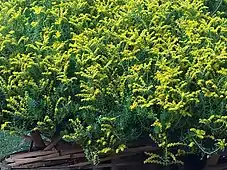Sedum
Sedum is a large genus of flowering plants in the family Crassulaceae, members of which are commonly known as stonecrops. The genus has been described as containing up to 600 species, subsequently reduced to 400–500. They are leaf succulents found primarily in the Northern Hemisphere, but extending into the southern hemisphere in Africa and South America. The plants vary from annual and creeping herbs to shrubs. The plants have water-storing leaves. The flowers usually have five petals, seldom four or six. There are typically twice as many stamens as petals. Various species formerly classified as Sedum are now in the segregate genera Hylotelephium and Rhodiola.
| Sedum | |
|---|---|
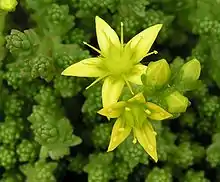 | |
| Biting stonecrop (Sedum acre) | |
| Scientific classification | |
| Kingdom: | Plantae |
| Clade: | Tracheophytes |
| Clade: | Angiosperms |
| Clade: | Eudicots |
| Order: | Saxifragales |
| Family: | Crassulaceae |
| Subfamily: | Sempervivoideae |
| Tribe: | Sedeae |
| Genus: | Sedum L.[1] |
| Type species | |
| Sedum acre | |
| Subgenera | |
| |
| Synonyms | |
|
List
| |
Well-known European species of Sedum are Sedum acre, Sedum album, Sedum dasyphyllum, Sedum reflexum (also known as Sedum rupestre) and Sedum hispanicum.
Description
Sedum is a genus that includes annual, biennial, and perennial herbs. They are characterised by succulent leaves and stems.[2] The extent of morphological diversity and homoplasy make it impossible to characterise Sedum phenotypicaly.[3]
Taxonomy
Sedum was first formally described by Carl Linnaeus in 1753, with 15 species.[4] Of the genera encompassed by the Crassulaceae family, Sedum is the most species rich, the most morphologically diverse and most complex taxonomically. Historically it was placed in the subfamily Sedoideae, of which it was the type genus. Of the three modern subfamilies of the Crassulaceae, based on molecular phylogenetics Sedum is placed in the subfamily Sempervivoideae. Although the genus has been greatly reduced, from about 600[5] to 420–470 species,[6] by forming up to 32 segregate genera,[7] it still constitutes a third of the family and is polyphyletic.[8]
Sedum species are found in four of six major crown clades wthin subfamily Sempervivoideae of Crassulaceae and are allocated to tribes, as follows:[9]
| Clade | Tribe |
|---|---|
| Hylotelephium | Telephieae |
| Rhodiola | Umbiliceae |
| Sempervivum | Semperviveae |
| Aeonium | Aeonieae |
| Acre | Sedeae |
| Leucosedum | |
| Note
Clades containing Sedum, shown in blue | |
In addition at least nine other distinct genera appear to be nested within Sedum. However the number of species found outside of the first two clades (Tribe Sedeae) are only a small fraction of the whole genus. Therefore the current circumscription, which is somewhat artificial and catch-all must be considered unstable.[8] The relationships between the tribes of Sempervivoideae is shown in the cladogram.
| Cladogram of Sempervivoideae tribes[9] | |||||||||||||||||||||||||||
|
There are now thought to be approximately 55 European species. Sedum demonstrates a wide variation in chromosome numbers, and polyploidy is common. Chromosome number is considered an important taxonomic feature.[10]
Earlier authors placed a number of Sedum species outside of these clades, such as S. spurium, S. stellatum and S. kamtschaticum (Telephium clade),[11] that has been segregated into Phedimus (tribe Umbiliceae).[9][12][13][14] Given the substantial taxonomic challenges presented by this highly polyphyletic genus, a number of radical solutions have been proposed for what is described as the "Sedum problem", all of which would require a substantial number of new combinations within Sempervivoideae. Nikulin and colleagues (2016) have recommended that, given the monophyly of Aeonieae and Semperviveae, species of Sedum outside of the tribe Sedeae (all in subgenus Gormania) be removed from the genus and reallocated. However this does not resolve the problem of other genera embedded within Sedum, in Sedeae.[8] In the largest published phylogenetic study (2020), the authors propose placing all taxa within Sedeae in genus Sedum, and transferring all other Sedum species in the remaining Sempervivoideae clades to other genera. This expanded Sedum s.l. would comprise about 755 species.[15]
Subdivision
Linnaeus originally described 15 species, characterised by pentamerous flowers, dividing them into two groups; Planifolia and Teretifolia, based on leaf morphology. with 15 species, and hence bears his name as the botanical authority (L.).[16] By 1828, de Candolle recognized 88 species, in six informal groups.[17] Various attempts have been made to subdivide this large genus, in addition to segregating separate genera, including creation of informal groups, sections, series and subgenera. For an extensive history of subfamily Sedoideae, see Ohba 1978.
Gray (1821) divided the 13 species known in Britain at that time into five sections; Rhodiola, Telephium, Sedum, (unnamed) and Aizoon.[18] In 1921 Praeger established ten sections; Rhodiola, Pseudorhodiola, Giraldiina, Telephium, Aizoon, Mexicana, Seda Genuina, Sempervivoides, Epeteium and Telmissa.[19] This was later revised in what is the best known system, that of Berger (1930), who defined 22 subdivisions, which he called Reihe (sections or series).[20] Berger's sections were:
- Rhodiola
- Pseudorhodiola
- Telephium
- Sedastrum
- Hasseanthus
- Lenophyllopsis
- Populisedum
- Graptopetalum
- Monanthella
- Perrierosedum
- Pachysedum
- Dendrosedum
- Fruticisedum
- Leptosedum
- Afrosedum
- Aizoon
- Seda genuina
- Prometheum
- Cyprosedum
- Epeteium
- Sedella
- Telmissa
A number of these, he further subdivided.[20] In contrast, Fröderströmm (1935) adopted a much broader circumscription of the genus, accepting only Sedum and Pseudosedum within the Sedoideae, dividing the former into 9 sections.[21] Although this was followed by numerous other systems, the most widely accepted infrageneric classification following Berger, was by Ohba (1978).[22] Prior to this most species in Sedoideae were placed in genus Sedum.[12] Of these systems, it was observed "No really satisfactory basis for the division of the family into genera has yet been proposed".[23]
Some other authors have added other series, and combined some of the series into groups, such as sections.[24] In particular Sedum section Sedum is divided into series (see Clades) [8][2] More recently, two subgenera have been recognised, Gormania and Sedum.[8]
- Gormania: (Britton) Clausen. 110 species from Sempervivum, Aeonium and Leucosedum clades. Europe and North America.
- Sedum: 320 species from Acre clade. Temperate and subtropical zones of Northern hemisphere (Asia and the Americas).[25]
Subgenus Sedum has been considered as three geographically distinct, but equal sized sections:[25]
- S. sect. Sedum ca. 120 spp. native to Europe, Asia Minor and N. Africa, ranging from N. Africa to central Scandinavia and from Iceland to the Ural Mountains, the Caucasus and Iran.
- S. sect. Americana Frod.
- S. sect. Asiatica Frod.
S. sect. Sedum includes 54 species native to Europe, which Berger classified into 27 series.[25]
Subgenus Gormania
Of about 80 Eurasian species, series Rupestria forms a distinct monophyletic group of about ten taxa, which some authors have considered a separate genus, Petrosedum.[31][32][33] It was series 20 in Berger's classification. Native to Europe it has escaped cultivation and become naturalized in North America.[34]
|
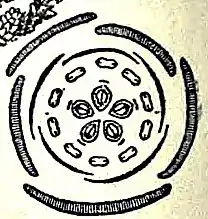
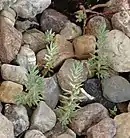
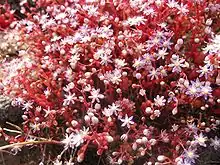
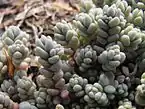
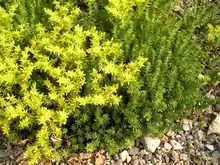
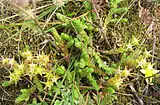
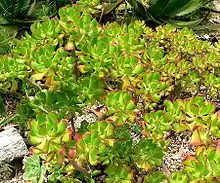
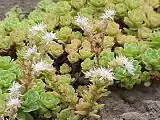
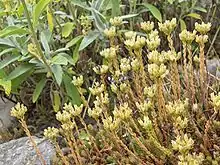
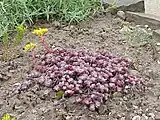
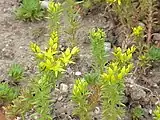
.jpg.webp)
